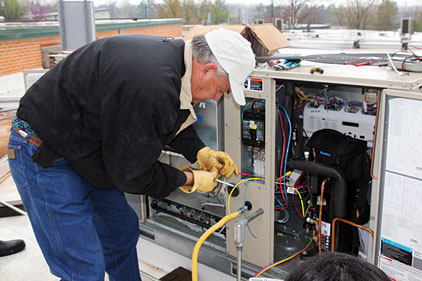Condenser subcooling ensures that there is a liquid seal at the condenser’s bottom so the liquid line or receiver will not be fed with vapors. This condition prevents any noncondensables, like refrigerant vapor or air, from leaving the condenser’s bottom and entering the receiver or liquid line. On systems without receivers, condenser subcooling can be an indicator of how much refrigerant charge is in a system. See the manufacturer’s specifications for condenser subcooling amounts when charging a system using these criteria.
Another important reason why condenser subcooling must be present is to prevent liquid line flash gas (vapor bubbles) from forming in the liquid line. Liquid line flash gas is primarily caused from pressure drop in the liquid line. Pressure drop in the liquid line can be caused from any restrictive device, including filter dryers, sight glasses, solenoid valves, shutoff valves, kinked or undersized liquid lines, large liquid line runs, and large vertical lift in the liquid line.
There is pressure drop associated with the length of run and the vertical lift of liquid in refrigerant lines. The longer the run and the more turns and bends associated with the liquid line, the larger the associated pressure drop.
Also, the farther you try to vertically lift liquid, the more pressure drop will be associated with the lift. If there wasn’t any condenser subcooling, saturated liquid from the condenser, while experiencing these pressure drops, would continuously be trying to reach a new, lower saturated temperature because of the pressure/temperature relationship associated with saturation.
The saturated liquid would be trying to cool itself down to a new lower saturation temperature to match the progressively lower pressure in the liquid line. The only way the saturated liquid could cool itself down is for some of its own liquid to flash into vapor.
Whenever a liquid flashes into vapor, heat energy is needed for the vaporization process. Almost all of the heat supplied to the flashing process comes from the heat in the saturated liquid itself. This cools the remaining liquid down to the new saturation temperature associated with the new, lower pressure caused from the pressure drops in the liquid line on the way to the metering device.
This type of cooling is referred to as adiabatic cooling because there is no net loss or gain of energy in the subcooled liquid itself. The heat needed for the flashing of the liquid came from the liquid itself. So, whenever saturated liquid experiences liquid line pressure drops, liquid line flash gas will result and is detrimental to system performance. Metering devices will now experience a mixture of liquid/vapor instead of a solid column of liquid at their entrances. The liquid/vapor mixture will decrease the capacity of the thermal expansion valve (TXV) because TXV capacity tables are based on vapor‑free liquid at their inlets.
Also, when liquid flashes in the liquid line, it leaves less liquid to flash in the evaporator and thus takes away from the refrigeration effect and adversely affects system capacity.
The balanced port TXV is designed to handle a certain amount of flash gas due to its oversized port. It is designed to maintain better control under such conditions and at light loads. The balanced port TXV can operate with its valve pin very close to the seat. This allows a large port to handle small loads.
Pressure Drop
Total pressure losses that take place in the liquid line are the result of two types: friction pressure losses and static pressure losses.
Friction pressure losses were mentioned earlier. They are caused from refrigerant flowing either through tubing, driers, elbows, or even a sight glass on its way to the metering device. Some of the fluid’s energy is being used to overcome friction from the side walls of the pipe or from an obstruction such as the filter drier.
A velocity profile is actually set up in the pipe with the slowest-moving fluid at the sidewalls, and the fastest-moving fluid in the center of the pipe. This lost energy in the fluid causes a loss in pressure, and is why liquids must be subcooled before experiencing these pressure drops to prevent liquid flashing. Proper line sizing, short runs, and unobstructed accessories like clean filter driers can prevent excessive friction pressure drops.
Static pressure losses occur in the liquid line whenever liquid has to flow uphill through vertical lifts. A vertical column of liquid naturally has more pressure at its bottom than its top, due to the weight of the entire column of liquid at the bottom. So, anytime liquid from a condenser or receiver has to be piped uphill, there will be static pressure drops as the liquid climbs higher in the piping. This is in addition to the friction pressure losses from the pipe’s sidewalls as the liquid climbs.
Publication date: 03/05/2012



Report Abusive Comment